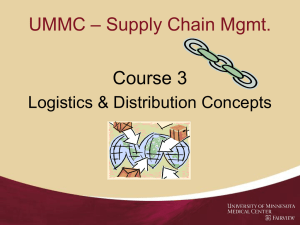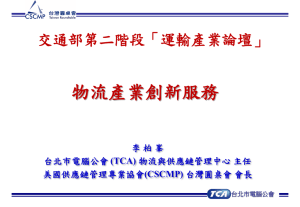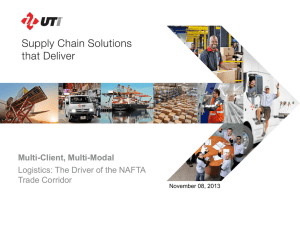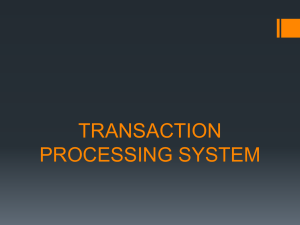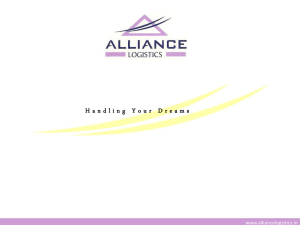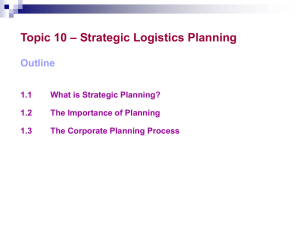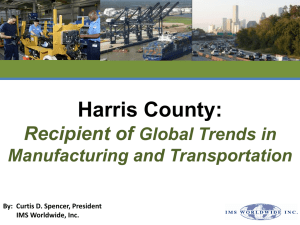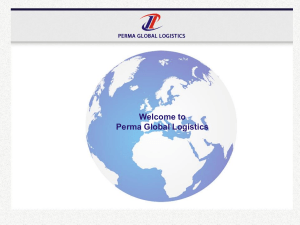Determining Optimal Level of Product Availability
advertisement
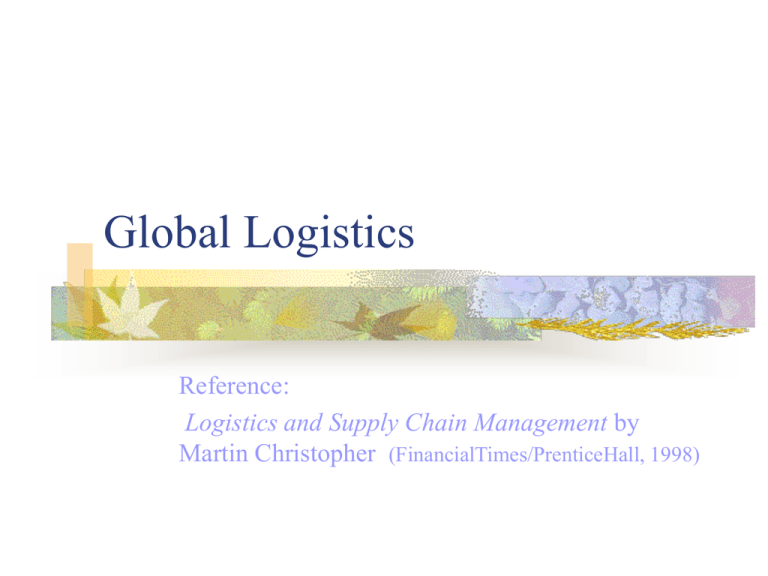
Global Logistics Reference: Logistics and Supply Chain Management by Martin Christopher (FinancialTimes/PrenticeHall, 1998) Outline Globalisation and its implications Challenges for global logistics How the leading-edge companies manage logistics The new organisational paradigm Managing the supply chain of the future 2 Globalisation Trends Worldwide cross-border trade is estimated to increase from US$5.9 trillion in 1999 to US$8.4 trillion in 2005. 51 of the 100 largest economies in the world are corporations, not countries. Wal-mart is bigger than Indonesia, NTT is bigger than Ireland. Global brands now dominate most markets: Coca- cola, IBM, Toyota, etc. These companies seek to extend its markets worldwide whilst seeking cost-reductions through scale economies by sourcing globally Drivers of Globalisation Global trade liberalisation; Trade barriers diminishing Multi-national companies evolving into real global organisations Production out-sourcing to lower cost regions Improved logistics infrastructure and operations 3 Why Companies Go Global? Global Market Forces •Local market saturation •Foreign demand growth •Competition at home Global Cost Forces •Labor cost •Raw materials cost Globalization Political and Economical Forces •Regional trade agreements •Tariff & tax incentives overseas •Local content requirements © Zhi-long Chen Technological Forces •Access to specific technologies •Speed to market (integrate R&D and manufacturing) 4 But…Global Operations are Not Simple • Issues & risks in global supply chains: -- Infrastructure in developing countries -- Cultural, language, labor skill differences -- Government stability, legal systems, regulations -- Currency exchange rate fluctuation -- Duties & tariffs -- Different corporate tax rates -- Import/export quotas -- Local content rules -- Product design issues (local customer needs) -- Longer transportation lead times -- Quality/reliability of local suppliers © Zhi-long Chen 5 Nike: the logistics challenge of global business Nike: re-created the sport shoe as “high-tech, high-performance” products that is an icon of youth subculture, with a price to match! Core business: state-of-the-art R&D capabilities ruthless low-cost manufacturing “Air Max Penny” basketball shoe: designed in Oregon and Tennessee, manufactured in South Korea and Indonesia from 52 components sourced from Japan, South Korea, Taiwan, Indonesia and USA. Nike markets over 300 new shoe design each year, leading to costly overstocks if sales forecasts not achieved. Distribution in USA is outsourced to third-party logistics providers with IT linkage to Nike’s global sales and customer support systems, enabling sales/inventory information to be accesible to all decision makers concerned. When the supply chain is global and the products are fashion-oriented, the management of logistics becomes a key determinant of business success or failure. 6 Domestic vs. Global Business What is a global business? More than just a company that exports source materials and components from more than one country geographically dispersed manufacturing/assembly locations market products worldwide 7 Challenges facing global businesses local variations in markets (consumer preferences) e.g. left-hand drive and right-hand drive cars e.g. voltage and socket variations by country production process complications complex logistics of global supply chains co-ordination of production and transportation cross-docking, merge-in-transit economies of scale --> global cost competition 8 Key Issues in Global Logistics Strategy Appropriate degree of centralisation? Management Manufacturing Distribution How can the needs of local markets be met while gaining economies of scale through standardisation? 9 Focussed Factories Limit the range and mix of products manufactured at a single location to achieve economies of scale Instead of “local-for-local” production, each location produces a few items for the world market e.g. Heinz makes all the ketchup for Europe in only 3 plants and switches production depending on local costs, demand, and currency fluctuations Is using the global lowest-cost producer always the best strategy? 10 Focussed Factories: Concerns Effect on transportation costs? Effect on delivery lead times? For high-tech products, usually < 10% is direct labour Local variations in product requirements More local safety-stock needed Effect on overall savings Especially on low-value, low-margin products e.g. packaging styles, language labels Customers order a variety of products from the same producer on a single order; but product now produced in focussed factories in diverse locations Product flexibility? Variety? Responsiveness? 11 Centralisation of Inventories Pooling of inventories reduces cycle stock (EOQ square-root rule!) Pooling of inventories also reduces safety stock Philips reduced consumer electronics products warehouses in Europe from 22 to 4 Drawbacks: higher transport costs longer delivery lead times 12 Virtual Inventory Consolidation Locating inventory near the customer, but managing and controlling it centrally ‘Virtual’ inventory reduces double-handling and physical transportation costs Requires an information system that can provide complete visibility of demand from one end of the supply chain to the other in as close to realtime as possible To be response, transport costs may also increase (e.g use of couriers for speedy delivery) 13 Postponement and Localisation Significant local difference in customer and consumer requirements e.g. refrigerators, cars Postponement: design products to use common platforms, components and modules delay final assembly/customisation as much as possible until final market destination and customer requirements known 14 Advantages and concerns of Postponement Generic inventory -> fewer stock-keeping variants flexibility and variety in products forecasting is easier at the aggregate generic level than at individual SKU level Mass-customisation “design for localisation” maximise variety using fewest basic components final customisation out-sourced to local distribution centres 15 E-commerce: Business and Logistics Concerns Domestic --> International --> Multi-national Global (Table abridged from “e-Global Logistics” by Robin Roberts, Stephens Inc., 2000.) 16 National Brick-&Mortar companies doing business internationally National e-commerce companies doing business internationally Physical location No foreign office No foreign office Foreign trading partners Finite in number Aware and business priority for global logistics Usually Low (not strategic) Suppliers: finite Customers: infinite Usually Low Usually High (not strategic) (competitive advantage) Few More Suppliers: finite Customers: infinite Very High (core strategic) (logistics integrators) (several FFs, brokers, carriers) Low Medium High Issues Intermediaries Few in supply chain (freight forwarders) Global SCM challenge Low Multinational companies Global companies Independent operations in multiple countries Finite in number Close-knit operations in multiple countries regardless of national borders Many (many FFs, brokers, carriers) 17 Issues SCM System sophistication National Brick-&Mortar Some system installed National e-commerce companies Multinational companies Global companies Not likely to have SCM system SCM system for planning and execution SCM system for planning and execution Demand/supply Predictable. (Few predictability contractual trade partners) Supply predictable. Demand variable. Relatively predictable. (Many contractual trading partners). Relatively predictable. (Many contractual trading partners; projected demand). Order Variability Low Low Medium High International fulfillment patterns Batch processing (Bulk) Real-time. Small lot pick&-ship. Batch processing (Bulk) Batch processing (Bulk) Load Size Full container or LTL Small package Full container or LTL Full container or LTL Shipping Method Mostly ocean Mostly air Mostly ocean Mostly ocean 18 National Brick-&Mortar Issues National e-commerce companies Multinational companies Global companies Import Quota requirements Yes Not likely Yes Yes Local Taxation considerations Relatively complex due to large shipment size Relative simple (for small packages) Relatively complex due to large shipment size Very complex, use of free trade zones and duty regulations Payment mechanisms Credit cards, letter of credit (LC) Mostly credit cards Mostly LCs, Mostly wire transfers, ACH Trade documents requirement Medium complex Relatively simple Major Challenge in International Logistics Lack of knowledge of international logistics; Customers do not know landed costs for sourcing comparisions Lack resource and expertise to handle international logistics; Customers do not know landed costs for sourcing comparisions documents against acceptance, wire transfers Relatively complex, due to volume and payment methods Lack of easy interface with trading partners’ systems. Manual process for trade compliance and cost estimates slow. (automatic clearing house) transactions Very complex, due to large shipments, countries involved and taxation issues Lack of seamless integration of business processes and info systems with trading partners. Manual process for trade compliance and cost estimates slow. 19 Key Challenges of Global Logistics Extended lead times of supply Extended and unreliable transit times Multiple consolidation and break-bulk options Multiple freight mode and cost options International trade and finance issues Duty, tariffs, taxes, customs Trade compliance: import ceilings and quotas, joint-venture requirements Cash flow, currency fluctuations, financial exposure concerns Total landed costs can be much higher than traditional domestic logistics (transportation + warehousing) costs 20 Extended supply lead times and transit times Long manufacturing lead-times are sometimes artificial Intermediate inventory needed to buffer against unreliable transit times Mind-set change from make-to-stock to make-to-order sea freight from Rotterdam to Japan takes 5 weeks (a lot of inventory tied up at sea!) air-freight options may be attractive if total costs considered International shipping, consolidation and customs delays are significant As variability increases, local managers tend to compensate by over-ordering, double-buffering and requesting more allocation Instead, should explore transportation options and examine supply chain to reduce variability, increase shipment visibility and tracking 21 Complex Consolidation/BreakBulk Supply Network Multiple Shipment options: direct ship from each source to final market in full containers consolidate in the supply region for final market in full containers Consolidate from each source for each consumer region with break-bulk/intermediate inventory in region Consolidate in the supply region and also break-bulk in the consumer region 22 Multiple freight mode and costs options Variety of shipping services available Air vs sea freight: Integrators provide “door-to-door” service air freight transport cost expensive, but may be worthwhile when inventory holding costs, potential lost revenue and market flexibility taken into account DHL, FedEx, UPS, TNT shorter and more reliable transit times swifter and less complicated procedures, e.g. customs clearance worldwide tracking and tracing capability Need for end-to-end pipeline management co-ordinate export dept, shipping dept, freight forwarder Compartmentalised decision-making (e.g. shipping dept, export dept) may focus on ‘wrong’ or ‘partial’ objectives and lead to sub-optimal decisions. 23 Organising for global logistics Centralisation vs. Decentralisation? Efficiency vs. responsiveness? Global vs local decision making Local decision making preferable in sales, promotion and marketing Key principles: Strategic structure and control of logistics flows centralised for worldwide cost optimisation Customer service localised for competitive advantage Global co-ordination is key, especially if many functions out-sourced Global logistics information system is the pre-requisite for achieving local service needs and global cost optimisation 24 Logistics Structure and Control If the potential trade-offs in rationalising sourcing, production and distribution across national boundaries are to be achieved, then it is essential that a central decision-making structure for logistics is established. Martin Christopher Location decisions fundamentally affects the supply chain operations long-range impact; investments in fixed assets and equipment exchange rate and different regional costs must consider total cost (Activity-Based Costing) 25 Customer service management Local markets have their own specific characteristics and needs opportunities for tailoring service against local customer requirements Monitoring of service needs and performance management of entire order-fulfillment process 26 Out-sourcing and partnerships Trend towards out-sourcing, not only for materials and components, but also for services Focus on core competencies Logistics: provision of warehousing, inventory control (VMI) and transportation is increasingly out-sourced Co-ordination and liaison with strategic partners is crucial 27 Logistics Information Systems Only with updated and accessible information can the complex flows of goods be co-ordinated to achieve costeffective service “Substitute Information for inventory” “ Look down the pipeline into end-user markets” to better see true demand 28 Global co-ordination vs. Local Management Global functions: Network structure for production and transportation optimisation Information systems development and control Inventory positioning Sourcing decisions International transport mode and sourcing decisions Trade-off analysis and supply chain cost control Local functions: Customer service management Gathering market intelligence Warehouse management and local delivery Customer profitability analyses Liaison with local sales and marketing management Human resource management 29 Characteristics of Companies at the Leading Edge of Logistics Survey by Council of Logistics Management in North America: Exhibit an over-riding commitment to customers Emphasise planning Encompass a significant span of functional control Commit to external alliances with service providers Have a highly-formalised logistical process Place a premium on operational flexibility Employ comprehensive performance measurement Invest in state-of-the-art information technology 30 Concerning organisational structure, leading edge firms: Have had formal logistics organisations longer Tend to have logistics headed by an officer-level executive Adopt more fluid approach to logistics organisation; encourage frequent re-organisation to take advantage of opportunities Favour centralised control Becoming more centralised as they adapt organisational structure to corporate mission More apt to execute boundary-spanning or externally-oriented logistics functions Tend to manage more beyond or extended functional responsibilities not traditionally considered part of logistics 31 Concerning strategic posture, leading edge firms: Have a greater tendency to manage logistics as a value-added process Reflect a stronger commitment to achieving and maintaining customer satisfaction Place a premium on flexibility, particularly in accommodating special or non-routine requests Are better positioned to handle unexpected events Are more willing to use outside service providers Place a premium on how well the service company performs in managing itself and its service to clients Are more apt to view service-provider relationships as strategic alliances Anticipate greater use of outside services in the future 32 Concerning managerial behaviour, leading edge firms: Expend more effort on formal logistics planning Are more apt to publicise their performance commitments and standards by issuing specific mission statements Are more apt to have chief logistics officers involved in business unit strategic planning Respond effectively to non-planned events Regularly use a wider range of performance measures, including asset management, costs, customer service, productivity and quality Are more significant users of information processing technology and enjoy a higher quality of information systems (IS) support Typically have more state-of-the-art computer applications and are planning more updates and expansions Are more involved in new technology such as electronic data interchange (EDI), artificial intelligence (AI), etc. 33 The new organisational paradigm Traditionally, organisations are hierarchical, vertical and functionally defined Current and future business environment: focus on “speed”, just-in-time, short product life-cycles volatile demand flexibility in customer requirements Challenge: how to be a responsive organisation? 34 Distinguishing features of the responsive organisation Focus will shift: From functions to processes From profit to performance From products to customers From inventory to information From transactions to relationships 35 From functions to processes Conventional organisations organised around functional silos inwardly focussed, concentrates on use of resources Organisations actually compete on “capabilities” product development, order fulfilment, etc. through these processes are the customers satisfied capabilities reflect processes which require coordination and co-operation horizontally across t he organisation 36 From profit to performance Profit is the end, but the means important too “What gets measured gets managed” Performance drives profitability “New” performance indicators customer satisfaction: customer retention, brand preference, dealer satisfaction, service performance flexibility: commonality of components, reduction of process complexity, set-up times people commitment: employer turnover, suggestions submitted and implemented, internal service climate and culture, training and development 37 From products to customers Move away from focus on products e.g. brand managers, product group managers Re-focus on customer satisfaction and demand management Emphasis on customer value Need to be supported by accounting systems that better identify the cost of servicing the customers Logistics and marketing need to be managed conjointly 38 From inventory to information “uncertainty is the mother of inventory” “forecasts are never right” Feedback information on actual usage! Substitute information for inventory Benetton: capture information at point-of-sale early in the season flexibility in production process reduce reliance on (highly inaccurate) fashion forecasts 39 From transactions to relationships Tradition: focus on market share and winning customers Keeping customers important the longer customers stay, the more profitable customers who drift from one supplier to another more difficult to satisfy than loyal and committed customers Benefits of “single sourcing”: improved quality innovation sharing reduced costs integrated scheduling of production and deliveries barriers to entry of competitors 40 Managing the supply chain of the future Since it is through people that change is created, attention must be paid to how the organisation develops a set of skills and competencies that are appropriate to the constantly changing external environment. - Martin Christopher 41 Managing the supply chain of the future Paradigm shift Leading to Skills required From function to processes Integral management of materials and goods flow From products to customers Focus on markets and the creation of customer value From revenue to performance Focus on the key performance drivers of profit From inventory to information Demand-based replenishment and quick response systems Supply chain partnerships Cross-functional management and planning skills Ability to define, measure and manage service requirements by market segments Understanding of the “cost-to-serve” and timebased performance indicators Information systems and information technologies From transactions to relationships Relationship management and win-win orientation 42 Role of information in the virtual supply chain Internet and other IT technologies can now link the customer directly to the supplier, and allow the supplier to react, sometimes in realtime. Geographically dispersed “network” of specialists can be joined together to create innovative and cost-effective solutions for complex designs e.g. Boeing, Airbus, Infosys Tesco’s sets up information exchange extranets to implement efficient consumer response (ECR) to reduce waste and improve product availability on average, 5 to 10 % of products on promotion suppliers can access Tesco sales data and track their products enables the firm to estimate stock levels to fulfil promotions specifications for new products can be available on-line 43 The extended enterprise and the virtual supply chain Boundary-less horizontal process management across vendors, distributors, customers value-added exchange of information between partners Supply chain becomes a synergistic confederation of organisations with agreed common goals, each bringing specific strengths to the overall value creation Example: Smart Car 44 Making Change happen Clear vision of the role of logistics in the organisation significant organisational change new ways of working with upstream and downstream partners in the supply chain underpinning information systems established Effective leadership crucial 45 Summary Continuing trend towards globalisation global brands, global sourcing, focussed factories serving the world market Increased complexities: longer supply chains, more out-sourcing Need to balance the varying needs of local markets against the economic advantages of standardised procedures/products Challenge: a flexible and agile supply chain yet achieves economies of scale/scope Requires organisational change within firm and with supply change partners Integrated logistics planning; information technologies 46

